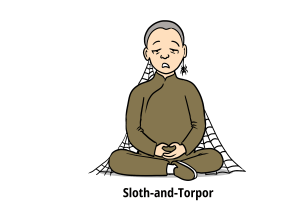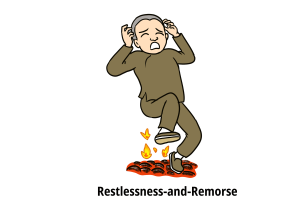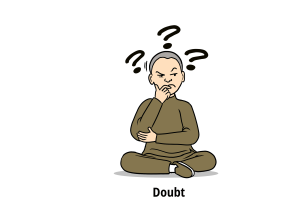
The five hindrances are mental obstacles that hinder the mind from meditative concentration. Beyond that, they also hinder the mind from wisdom in general, which means that they don’t just operate during meditation, they also operate in daily life. The five are:
- Sensual desire.
- Ill will.
- Sloth-and-torpor.
- Restlessness-and-remorse.
- Doubt.[1]

Sensual desire can be understood as the lust for the “five strands of sense pleasure”, which means objects that give pleasure to the five senses: pleasant sight, sound, smell, taste, touch. The pleasure arising from right samadhi, which does not depend on pleasing the five senses, is notably excluded from sensual desire.[2]
The best antidote to sensual desire is to develop the ability to experience the joy of the present moment when nothing is happening. One simple way is do that is whenever you are in an alert and relaxed state, notice that it is subtly pleasant. To be alert and relaxed is not a neutral state, it is a lightly joyful state. Once you are able to find that subtle pleasantness, give it your full attention, and indulge in it for as long as you can. The more you do it, the more the mind becomes familiar with it, and consequently, the more easily you can find that subtle joy. Soon, you will find yourself able to access it on demand! I.e., whenever you sit in meditation, with nothing happening at all, you can find that joy. (For details on the practice, see the book Joy on Demand, by yours truly). With that joy, sensual desire will find it much harder to grab hold of you.
A complementary antidote is to attend to grasping and aversion. After every sensation, there is perception, and the there can be either grasping or aversion. I suggest that the grasping and aversion is where the suffering is, and therefore, if you experience a sensation without grasping or aversion, then it can be experienced with no suffering (temporarily). The same with every thought and every desire. Therefore, the practice is to notice the arising of grasping and aversion when experiencing a sensation, a thought, or a desire, and then try to experience it without grasping or aversion. One way to reduce grasping, for example, is to meditate on the impermanent and unattractive nature of the object (also see “asubha practices” in mindfulness of the body). The more successfully you can do that, the less sensual desire can control you.

Ill will refers to mental states born of aversion, which include anger, hatred, resentment, jealousy and envy. These feelings can be directed towards other people, objects, situations, or even oneself.
The antidote to ill will is loving kindness. One highly effective way to do that is to cultivate the joy of loving kindness. Try this exercise now: for the next ten seconds, bring to mind somebody you care about, and then wish for that person to be happy. Do you notice you were smiling when you did that? To be on the giving end of loving kindness is intrinsically joyful. The practice is to wish people well a lot, and then bring full attention to that joy that accompanies loving kindness. The mind loves this kind of joy, so the more you do this, the bigger loving kindness expands in your mind and, the bigger it becomes, the more it pushes ill will away.

Sloth-and-torpor are actually two distinct mental states rolled into one hindrance. Sloth is characterized by dullness and lack of energy, while torpor is characterized by drowsiness and smothering unwieldiness.[3] Together, they describe a mind that is sleepy, saddled with mental inertia, and too “heavy” to wield.
The obvious solution to sloth-and-torpor is to increase energy. There are two things to increase: the quantity of energy, and the quality of energy. A lot of us modern people are chronically sleep deprived, which means we simply do not have sufficient quantity of energy. Formal meditation puts us in a state of stillness and relaxation, and if a sleep-deprived body finds itself in a state of stillness and relaxation, what does it want to do? It desperately wants to fall asleep, of course. Which is why so many modern meditators have so much trouble staying awake during meditation. The simple solution: get enough sleep. There are complementary practices, for example certain breathing techniques, that can give you a jolt of energy. But still, if you do not have enough sleep, nothing works better than simply getting enough.
If you already have enough sleep but still struggle with sloth-and-torpor, then you have to manage the quality of your energy. The best way to do that is to manage your motivation. For example, you can remind yourself how amazingly rare it is to be born a human being who is so extremely lucky that you get to learn the Dharma. Or, remind yourself that you will surely suffer old age, sickness and/or death someday, so if you don’t work hard enough to directly see nirvana while you still can, you are going to be so damned screwed. Such reminders are a little like lighting a small fire under your own gluteus maximus, it is guaranteed to make you jump up with energy, but in a good way.

Restlessness-and-remorse are also two distinct mental states rolled into one hindrance because they share the common feature of disquietude. Restlessness makes the mind unsteady, like wind makes a banner ripple, while remorse refers to regret and sorrow over what has been done (or not done) in the past.[4] Together, they describe a mind that is agitated and cannot be easily settled.
The best solution to restlessness is to develop the ability to experience the joy of the present moment, as we talked about for sensual desire. Whenever sitting is calmly joyful, restlessness is overcome.
Remorse is addressed by understanding that it comes from a good place: two mental states called hiri and ottappa. The Buddha calls hiri and ottappa “guardians of the world”[5], as if they are superheros that keeps the world in a good state. Wow. So, what are they? They are conscience and concern.[6] The Buddha says it is because people have conscience and concern that other people are protected from harm by them. Therefore, if everybody has those qualities, no harm would come to anyone. Furthermore, the Buddha also says that one who possess conscience and concern acquires a whole host of other good things, including heedfulness, good friends, and virtue, that lead all the way to liberation from suffering.[7] If you have remorse, it means you are capable of conscience and concern, and that is a good thing.
There is one other compounding factor. See, the spiritual path is one of increasing wisdom and virtue, which means that if your practice has been going well, you are wiser and more virtuous today than you were before. But that also means that at one time, you must have been more foolish and less virtuous compared to today. Which means that very likely, something you did in the past must cause you remorse, when viewed with the wisdom you possess today.
So, the thing to recognize is that remorse comes from a good place: from the “guardians of the world” qualities of conscience and concern, combined with your spiritual growth over time. Once you recognize that, remorse becomes a motivation to be a much better person, so as to make up for the past and to create greater benefit to others for the future, rather than an excuse to beat yourself up. That is how to address remorse as a hindrance.

Doubt traditionally refers to the inability to place confidence in the Buddha, Dharma, Sangha (the monastic community)[8], and the training, and by extension, also the lack of confidence in one’s current teacher.[9] It can also extend to doubt in oneself [10], i.e., even if you have full confidence in the teachings and the teacher, you have no confidence in your own ability to carry it out. I find this perspective useful, because it afflicts me a lot.
The Buddha strongly encourages intelligent probing of his teachings, so why is doubt listed as a hindrance? Part of the answer is there are two types of doubt, an unhealthy doubt that undermines practice, and a healthy doubt that informs the practice. The hindrance here refers only to unhealthy doubt. The main difference is in the underlying attitude. The attitude underlying healthy doubt is an open-minded, intelligent curiosity that seeks to understand and clarify, while the attitude underlying unhealthy doubt is a strong negative bias that foolishly cannot be moved by fact or reason. In Buddhism, doubt is overcome not with blind faith, but with much learning and investigation.[11]
In addition, even healthy doubt can sometimes become a hindrance in a “wrong place, wrong time” situation. When you are learning to ride a bicycle, for example, if you are already on the bike pedaling wobblingly, it is precisely the wrong time to ask yourself, “Can the laws of physics actually enable me to balance on two wheels?” No, don’t do that! What you need to do at that moment is to just pedal and try to keep balance. The question concerning the laws of physics is a good and correct one to ask, but not at the moment you are pedaling and wobbling. Asking it at that time is counter-productive because it interferes with the practice. In the same way, while you’re in the middle of meditation practice, questions such as, “Is the human mind actually capable of calming down?” or “Is the Buddha an actual historical figure?” interfere with the practice and are, hence, counter-productive. They are good questions, and there are proper times to ask them, and the middle of meditation practice is usually not it.
As usual, the Buddha gives us delightful similes. The Buddha compares the five hindrances to strangler figs. A strangler fig tree starts its life as a seed dropped onto a host tree by a bird or an animal. It then grows roots all around the trunk of the host tree, all the way into the ground. Eventually, it envelops the host tree and strangles it to death. In the same way, the five hindrances encircle and strangle the mind and, in doing so, they weaken wisdom.[12] Yes, a gripping simile indeed.

In addition, the Buddha also gives us a set of similes to help us understand each of the five hindrances. He compares the hindrances to a man in an assortment of crappy situations.[13] One afflicted with sensual desire is like a man taking on debt. Every debt must be repaid with interest, or be extended (and incur even more interest in the future). In the same way, every sensual pleasure indulged must be repaid later with even more suffering through eventual loss, separation, or death; or, it creates more sensual desire in the future. One who is free from sensual desire is like a man whose business prospered and made enough money to pay off all his debts, he rejoices!
One afflicted with ill will is like a man who is sick. Ill will is like a serious disease, it causes you pain and destroys you from the inside out. One who is free from ill will is like a man who recovered from sickness, he rejoices!
One afflicted with sloth-and-torpor is like a man in prison, bounded and unable to do what he wants to do. A festival, for example, goes on near the prison, and he misses the entire thing. One who is free from sloth-and-torpor is like a man released from prison, he rejoices!
One afflicted with restlessness-and-remorse is like a slave whose master forces him to do this or that; he has no agency or autonomy, he can’t even rest when he wants to. One who is free from restlessness-and-remorse is like the slave released from slavery, he rejoices!
One afflicted with doubt is like a traveler lost in a desert where food is scarce and dangers abound. One who is free from doubt is like the lost traveler arriving safe and sound at the edge of a village, he rejoices!
Notice that every simile has one important thing in common? In every simile, when the man finds himself out of his crappy situation, he rejoices. Joy is his internal measure of success. This is an important point, because freedom from the five hindrances is not a neutral state, it is a joyful state. This joy born of freedom from the five hindrances is very wholesome, and as we will see later in this series, is an important propellant towards nirvana.
Activities
References
[1] In Pali: kāmacchanda, vyāpāda (also spelled byāpāda), thīna-middha, uddhacca-kukkucca and vicikicchā, respectively.
[2] Ajahn Brahm, The Five Hindrances. Buddhist Society of Western Australia, Newsletter April 1999. https://www.budsas.org/ebud/ebmed051.htm.
[3] Bhikkhu Bodhi, Comprehensive Manual of Abhidhamma: The Abhidhammattha Sangaha.
[4] Ibid.
[5] Itivuttaka 42.
[6] Soryu’s favorite translation of hiri and ottappa are “moral shame” and “moral dread” (i.e., fear of wrongdoing). These provocative but accurate translations wake people up to the fact that they almost never experience shame and dread as positives. In truth, shame and dread can be used to propel you on the path.
[7] Aṅguttara Nikāya 10.76.
[8] These are known as the Triple Gem. We will talk about them later in this series.
[9] Bhikkhu Bodhi, Comprehensive Manual of Abhidhamma.
[10] Ajahn Brahm, The Five Hindrances.
[11] This point is made in the medieval Buddhist commentary called the Sāratthappakāsinī.
[12] Saṃyutta Nikāya 46.39.
[13] Dīgha Nikāya 2. The original text gives five similes for the five hindrances, but does not explicitly link each simile to a hindrance. The explicit link is made in the later medieval commentaries.
All artwork in this post by Colin Goh.

